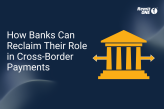Navigating the Payments and Remittance Landscape: Trends, Predictions, and Pioneering Progress October 23, 2023

The remittance landscape is in the midst of a remarkable transformation. From customer-focused innovations like mobile wallets, streamlining the remittance process, to the incorporation of artificial intelligence (AI) for more efficient operations. As we navigate through this changing financial terrain, it’s crucial to understand the evolving customer needs, which are increasingly leaning towards digital solutions for convenience and efficiency.
This article will unlock valuable insights into the trends and strategies shaping the payments and remittance industries whilst uncovering the challenges and opportunities that lie ahead.
Moderator:
- Leon Isaacs, CEO & Founder, DMA Global
Panellists:
- Wayne Gould, Head of Financial Services, Trust Payments
- Sukhi Srivatsan, Head of Account Management, AZA Finance
- Olufemi Olaogun, Head of Payments and Financial Institutions, Leatherback
- Richard Meredith, Head of Sales and Key Partners, Moneygram
What are key developments in the remittance landscape to look out for?
One key development which has emerged prominently in the remittance landscape is a growing emphasis on customer-oriented progress, as highlighted by Sukhi. This shift is evident through innovations like the invention of mobile wallets, designed to facilitate quick and hassle-free transactions for users. Mobile wallets have not only simplified the remittance process but have also enhanced the overall user experience, making it more convenient and accessible for a wider range of customers.
Another interesting and ongoing dynamic in the remittance sector revolves around the mobilisation and automation of payments to achieve greater efficiency. This involves the utilisation of cutting-edge technologies like AI to carry out repetitive tasks, thereby liberating valuable time for teams to concentrate on more critical and strategic areas. By leveraging AI in this manner, businesses in the payments and remittance space can significantly accelerate their progress and drive better results, all while ensuring that their operations remain swift and precise.
Multiple panel speakers also voiced blockchain and open banking to be game-changers. The integration of blockchain technology has simplified the movement of money, creating a more efficient and secure environment for processing transactions. Open banking, on the other hand, has enabled a more seamless and interconnected flow of funds. Together, these developments are propelling the industry toward a future where payments and remittances are not only faster and cost-effective but also imbued with a higher degree of transparency and security, ultimately benefiting merchants, financial institutions, and consumers alike.
What data or statistics highlight the future growth of the money transfer industry?
Customer expectations in the realm of remittances are undergoing notable shifts, as outlined by Richard. Despite economic downturns and recessions, the desire for people to respond to the financial needs of loved ones back home remains remarkably resilient. Notably, millennials are increasingly turning to digitalised methods for sending money, highlighting a growing preference for convenience and efficiency. A Moneygram survey revealed that over 80% of respondents expressed a willingness to send money back home, even in the face of economic challenges.
It’s important to note that these evolving expectations can vary significantly between geographical markets. For instance, in Mexico, more than 90% of individuals visit physical stores to collect their remittances, while in India, the approach leans more towards account-based methods. This geographical variance underscores the importance of tailoring strategies and pricing to meet the specific demands of each market.
In addition, as pointed out by Olufemi, customers now place a premium on the speed and cost-effectiveness of fund transfers. In essence, the evolving landscape of customer expectations in remittances is characterised by a growing demand for convenience, efficiency, and competitive rates, driving the industry to adapt and innovate to meet these changing needs.
What are some successful partnership case studies within the remittance or payments industry?
Leatherback forges partnerships to address a common challenge where customers may be uncomfortable conducting transfers with Money Service Businesses (MSBs) that lack a bank account. This collaboration ensures that businesses can continue their operations without the need for establishing local accounts in various countries, such as Nigeria, South Africa, or Ghana. This partnership-driven approach streamlines the process, eliminating potential bottlenecks and minimising expenses that would otherwise be associated with creating an internal team to handle these complexities.
Recognising the popularity of mobile wallets on the continent, Moneygram has built pivotal relationships with companies such as AZA Finance, Trust Payments, and strong partnerships in Ghana, including Z-pay. These collaborations have been crucial in expanding Moneygram’s reach and enhancing its ability to serve a broader receiving network. In India, where account-based money transfers are prevalent, this strategy has effectively reduced the digital side cost base, enabling Moneygram to diversify and enhance its product offerings in response to the ever-changing consumer demands.
Furthermore, Moneygram is actively exploring innovative solutions like blockchain technology, particularly with its partnership with Stellar. This initiative aims to facilitate the instant transfer of remittances to digital wallets, bridging the gap between traditional cash and cryptocurrencies. Notably, this approach holds the promise of reducing costs in the future, a significant advantage in the rapidly growing landscape of remittances. The success stories shared underscore the importance of adaptability and collaboration in navigating the remittance industry.
Can you share insights into business strategies that effectively utilise innovation whilst being cost-effective? Additionally, how do you approach security and fraud prevention strategies?
Some businesses may have deep-rooted traditional methods and personal client relationships, making the transition to online operations a significant paradigm shift. Wayne delves into how Trust Payments takes a consultative approach, employing dedicated teams that work closely with Money Transfer Operators (MTOs) to swiftly resolve issues, ensuring a strong connection to the business. They also focus on data-driven insights to provide a comprehensive view of their clientele, facilitating fraud prevention and ID verifications. He also shares how Trust Payments goes a step further by sharing data on popular fraud prevention parameters with their clients, allowing them to tailor their settings to their liking, therefore promoting an ecosystem of collaborative security and innovation.
Sukhi emphasises the critical role of compliance in safeguarding businesses and underscores the need to maintain security while pursuing innovation. She mentions the availability of consultancy services and tools that reduce manual intervention and human errors. These partnerships enable companies to cut costs and lower fraud rates, ultimately delivering more value to customers. Sukhi also highlights the importance of collaboration with regulators to navigate the legal framework and risks within the market, particularly in frontier markets. Recognising that many regulators in these regions cannot fully address the industry’s needs, she advocates for the industry’s engagement with governments and international bodies to bolster resources and foster a more secure and innovative environment.
What key steps or strategies are in place to improve financial inclusion?
Sukhi shed light on the steps taken to enhance financial inclusion, particularly in less developed markets. AZA Finance takes a comprehensive approach when entering new markets. They diligently study each partner’s tools and APIs, aiming to integrate with various financial providers, including banks, cash providers, and wallet services, based on the prevailing market preferences. What sets this approach apart is the recognition that in less developed markets, these APIs and tools are different from those found in more mature and open banking environments. In these frontier markets, the technical infrastructure may be less developed.
To bridge this gap and ensure financial inclusion, AZA Finance takes the initiative to engage with local staff and service providers. They establish a presence on the ground, engage in regulatory compliance, and establish connections with these providers to grasp how payments can be made into the preferred receiving methods of local consumers. By doing so, they consolidate these solutions and make them accessible to their business partners. This approach alleviates the need for each business to navigate the complexities of each market individually, ultimately contributing to the broader goal of financial inclusion. In essence, AZA Finance’s strategy exemplifies the importance of adaptability and personalised engagement in expanding financial access to underserved populations.
Richard also shared his ideas, where one strategy entails integrating the ability to manage all financial transactions within digital wallets. This means individuals can use their wallets not only for sending and receiving money but also for tasks such as paying bills and buying groceries. By interweaving money transfers into the fabric of these everyday financial activities, financial inclusion can be significantly enhanced.
One case study is of Safaricom in Africa, which initiated a journey towards financial inclusion by offering various financial services through its mobile platform. This successful model has since been adopted by various countries, not only in Africa but also in South America and Asia, contributing to broader financial accessibility.
While substantial progress has been made, there are still challenges in some regions due to varying levels of technology adoption and industry-player cooperation. In some cases, governments are actively engaging in discussions around fintech to boost financial inclusion. An intriguing example shared by Richard was the Turkish post office’s response to recent earthquakes. They swiftly set up booths in the affected areas to provide financial services, illustrating how financial inclusion can take different forms depending on each country’s unique circumstances and needs. The pursuit of financial inclusion remains a dynamic and evolving journey, tailored to diverse contexts and constantly adapting to better serve communities worldwide.
What opportunities are there for new players entering the remittances or payments market?
Adaptability is key for survival and success. Technology providers and fintech-based payment providers play a pivotal role in facilitating businesses of all sizes. These entities can assist not only in embracing the latest technologies but also in deploying effective marketing strategies to propel growth.
Partnerships are another avenue for newcomers to explore. Wayne highlights how Trust Payments, for instance, collaborates with various providers, including compliance, regulatory, and remittance as a service platform. These partnerships bring expertise to the table, allowing merchants to establish themselves more swiftly and efficiently than they might expect.
The success of new entrants in this competitive industry depends on having the right team and partners to expedite growth and expansion.
What next?
At RemitONE, our commitment is to provide you with cutting-edge technology, compliance solutions, and expert guidance to navigate the ever-evolving landscape of remittances. Whether you’re just starting out or looking to scale your business, we’ve got you covered.
Want to see how RemitONE can elevate your business? book a free consultation with our experts today!
Related Posts
-

How to Build a Leaner, Smarter Money Service Business in 2025
In an era of rapid regulatory change, rising customer expectations, and digital disruption, how can money service businesses (MSBs)—companies that…
May 22, 2025 -

Trump’s Threats to Cross-Border Payments: What It Means for Your Business
It’s been a short while since Trump stormed back into office, and he’s already shaken things up with his hard-hitting…
May 22, 2025 -

Unlock Faster, More Secure Payments with RemitONE’s Open Banking Solution
We’re excited to introduce the latest enhancement to our RemitONE Money Transfer Platform: the RemitONE Open Banking Solution. Competitively priced…
January 31, 2025 -

How to Expand Your SEND Operations in the UK and Europe—Without the Regulatory Hassle
The remittance market in Europe is valued at €133.7 billion annually, with the UK market contributing an additional £23 billion.
January 31, 2025 -

The Top 5 Cross-Border Payment Trends That Shaped 2024
What a year it’s been for the world of payments! From breakthroughs in tech to surprising shifts in consumer behaviour,…
December 19, 2024 -

How Banks Can Reclaim Their Role in Cross-Border Payments with RemitONE
Banks, once the cornerstone of international payments, are finding themselves sidelined. Senders and receivers have now joined forces, pushing banks…
December 18, 2024